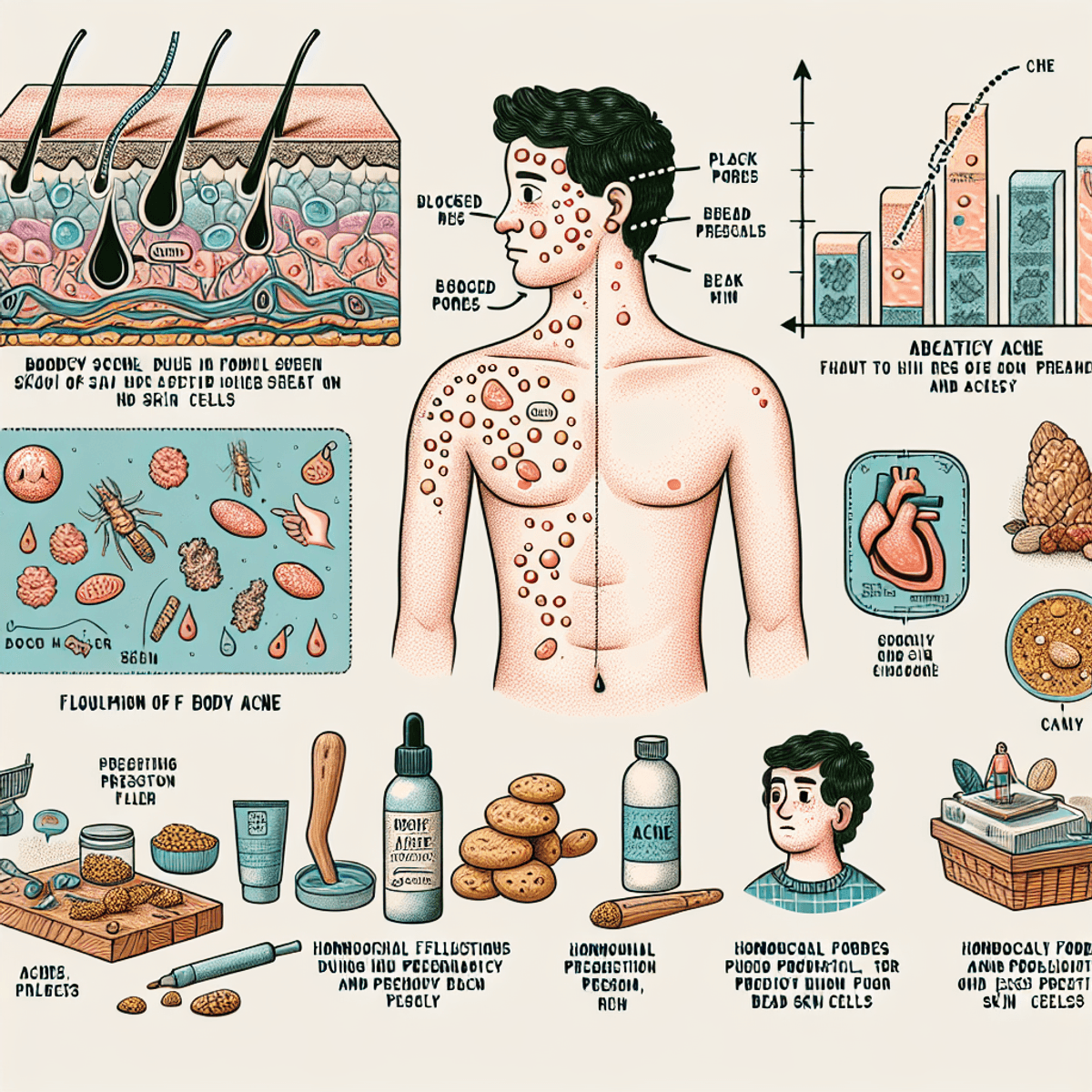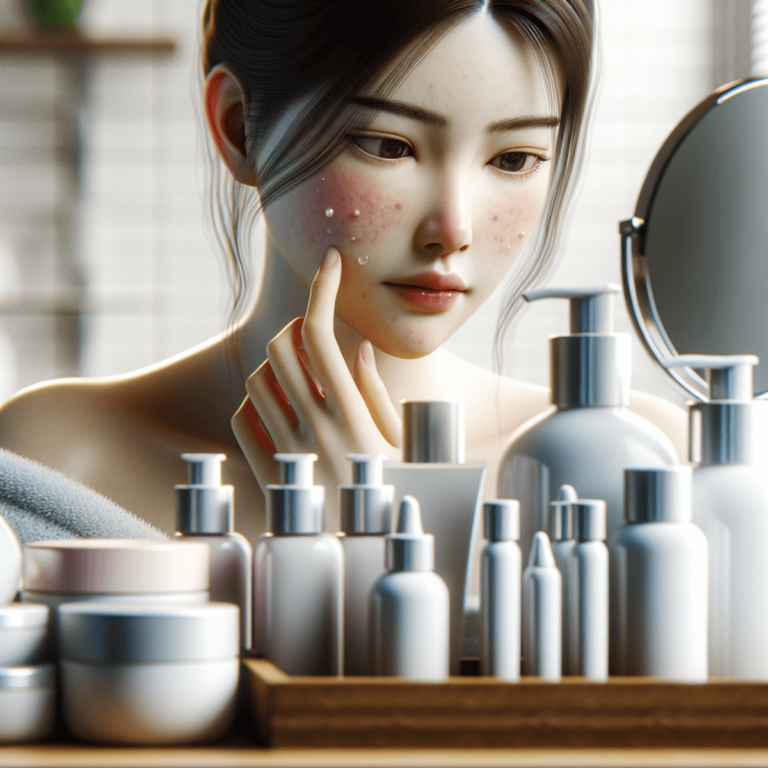Chest or Back: How to Get Rid of Body Acne

Introduction
Body acne, especially on the chest and back, is a common skin issue that many people face. It looks similar to facial acne but often has different causes like sweat, tight clothes, and too much oil production.
Chest acne usually happens when sweat and dead skin cells block pores. Back acne, or bacne, can get worse due to moisture and rubbing from clothes. Both types can seriously affect your confidence and overall well-being.
Treatments and lifestyle changes can effectively manage these conditions. Understanding the root causes and adopting targeted skincare routines are crucial steps in combating body acne. By incorporating specific products and habits into your daily regimen, you can achieve clearer skin and boost your self-esteem.
In this guide, you’ll discover various methods to tackle body acne, ranging from over-the-counter solutions to home remedies. Practical tips on prevention and when to seek professional help will also be covered.
Understanding Body Acne
Body acne, particularly on the chest and back, can be perplexing. Several factors contribute to its development:
Genetic Predisposition
Your genetic makeup plays a crucial role. If your parents or siblings have experienced body acne, you might be more prone to it. Genetics can influence your skin type, oil production, and how your pores respond to various stimuli.
Hormonal Fluctuations
Hormones are another significant factor. During puberty, pregnancy, or even due to menstrual cycles, hormonal changes can trigger excess oil production. This can lead to clogged pores and subsequent breakouts.
Dietary Choices
Your diet also affects skin health. Foods high in sugar and dairy have been linked to acne flare-ups. In fact, a study suggests that diet does play a role in adult acne, indicating that consuming a balanced diet rich in fruits, vegetables, and lean proteins may help manage body acne.
Excess Oil Production and Clogged Pores
Excess oil production is a common culprit behind breakouts. When your skin produces too much oil (sebum), it combines with dead skin cells to clog pores. Bacteria thrive in these clogged pores, leading to inflammation and pimples.
Common Triggers:
- Sweat: Sweat can mix with oils on your skin, leading to clogged pores.
- Tight Clothing: Clothing that doesn’t allow your skin to breathe can trap moisture and bacteria against your skin.
- Improper Hygiene: Infrequent showering or not cleansing properly after sweating can exacerbate body acne.
Understanding these causes of body acne helps in tailoring effective treatments. Knowing what triggers your breakouts enables you to adopt preventive measures and choose suitable products.
In addition to genetics, hormones, and diet, other lifestyle factors like stress and inadequate sleep can impact your skin’s health. Stress increases hormone levels that produce sebum, while lack of sleep affects overall body function, impairing the skin’s ability to heal itself.
Adopting a holistic approach that addresses these underlying factors is key in preventing and managing body acne effectively.
Chest Acne: Causes and Symptoms
Chest acne, commonly referred to as chest pimples, often arises from several specific causes. One primary reason is clogged pores. Sweat, oil, and dead skin cells build up and block these pores, leading to the formation of acne.
Causes of Chest Acne
- Sweat Accumulation: Engaging in physical activities or living in humid climates can lead to excessive sweating. When sweat mixes with oils and dead skin cells, it clogs the pores.
- Dead Skin Cells: The skin constantly sheds dead cells. If these cells are not exfoliated regularly, they can accumulate on the surface and contribute to blocked pores.
- Excess Oil Production: This can be due to genetics or hormonal fluctuations. Increased oil production creates an ideal environment for acne-causing bacteria.
Symptoms of Chest Acne
Chest acne shows up as:
- Red Bumps: Small red bumps that may be tender to touch.
- Whiteheads and Blackheads: Non-inflammatory pore blockages that appear as white or black dots.
- Pustules: Inflamed pimples filled with pus.
- Itchiness or Discomfort: Areas affected by chest acne may feel itchy or slightly painful.
Regularly addressing these contributing factors can help manage and reduce chest acne effectively.
Back Acne (Bacne): Understanding and Causes
Back acne, commonly known as bacne, affects a significant number of individuals. It shows up as pimples, blackheads, and cysts on the back, similar to facial acne but often more challenging to treat due to the area’s larger surface and thicker skin.
Unique Causes of Bacne Formation
Several factors contribute to the development of bacne:
- Tight Clothing: Wearing tight clothing can trap sweat and oil against the skin, leading to clogged pores. Lycra or synthetic fabrics commonly found in sportswear are frequent culprits.
- Moisture Retention: After physical activities like working out, sweat can accumulate on the skin. If not washed off promptly, this moisture can mix with dead skin cells and bacteria, exacerbating bacne.
- Hormonal Imbalances: Hormonal fluctuations, particularly during adolescence or menstrual cycles, can increase oil production leading to breakouts.
- Poor Hygiene: Infrequent showering or improper washing techniques can leave residue on the skin, clogging pores and leading to acne formation.
Understanding these unique causes is essential for effective bacne treatment. Identifying and addressing these contributing factors can significantly reduce the occurrence of back pimples.
Effective Treatments for Chest and Back Acne
Over-the-Counter Solutions for Chest and Back Acne
When it comes to managing chest and back acne, over-the-counter products can be highly effective. Understanding what to look for in these products is crucial.
Body Washes with Active Ingredients
Selecting body washes containing active ingredients like salicylic acid or tea tree oil can make a significant difference:
- Salicylic Acid: This beta-hydroxy acid penetrates the pores to exfoliate from within, helping to clear out excess oil and dead skin cells that clog pores. Products like Neutrogena Body Clear Body Wash are popular choices.
- Tea Tree Oil: Known for its natural antibacterial properties, tea tree oil can help reduce the bacteria that contribute to acne formation. Look for products such as The Body Shop Tea Tree Skin Clearing Body Wash.
Tips for Selecting the Right Product
Choosing the right product depends on your unique skin type:
- Oily Skin: Opt for body washes with higher concentrations of salicylic acid or benzoyl peroxide. These ingredients help manage excess sebum production.
- Sensitive Skin: Select gentler formulas containing soothing agents like aloe vera combined with mild exfoliants. A product like CeraVe SA Body Wash fits this category.
- Dry Skin: Look for hydrating body washes that contain both active ingredients and moisturizing elements like hyaluronic acid or glycerin.
Proper application is key. Use lukewarm water to open up the pores before applying these washes, allowing the active ingredients to penetrate more effectively.
Topical Treatments
Topical treatments provide targeted action against stubborn acne:
- Benzoyl Peroxide Gels: These work by killing acne-causing bacteria and reducing inflammation. Products such as PanOxyl 10% Benzoyl Peroxide Acne Foaming Wash are effective options.
- Salicylic Acid Lotions: Useful for regular use, salicylic acid lotions help in keeping pores unclogged over time. Paula’s Choice Clear Acne Body Spray is a recommended product.
Apply these treatments after showering when your pores are open and clean. This enhances absorption and effectiveness.
Home Remedies for Chest and Back Acne Relief
Natural remedies offer alternative solutions that many find beneficial:
- Aloe Vera Gel: Known for its anti-inflammatory properties, aloe vera can soothe irritated skin while promoting healing.
- Warm Compresses: Applying a warm compress helps in opening up clogged pores, making it easier to remove trapped oils and dead skin cells.
While home remedies can be helpful, they often work best when combined with other treatment methods rather than being relied upon solely.
Daily Habits to Prevent Body Acne Recurrence
Incorporating good hygiene practices into your daily routine can significantly reduce the risk of new breakouts:
- Regular Showering: Especially after sweating or exercising, regular showering removes sweat, oil, and dirt that contribute to clogged pores.
- Breathable Fabrics: Choose clothing made from materials like cotton which allows your skin to breathe more easily compared to synthetic fabrics.
Exfoliation Techniques for Clearer Chest and Back Skin
Exfoliation helps in removing dead skin cells that clog pores:
Scrubs vs. Chemical Exfoliants
Scrubs: Physical exfoliants like sugar scrubs can be effective but must be used gently to avoid irritation.
Chemical Exfoliants: Glycolic acid lotions or pads provide a gentle yet effective way to exfoliate without abrasive particles.
How often should you exfoliate? For most people, exfoliating 1-2 times per week is sufficient. Over-exfoliation can irritate the skin and exacerbate acne.
Understanding how different treatments work allows you to tailor a regimen that fits your specific needs, increasing the likelihood of achieving clearer skin on both your chest and back.
Home Remedies for Chest and Back Acne Relief
Natural remedies can offer a gentler approach to managing body acne, especially for those looking to minimize the use of chemicals. Here are some effective home treatments:
- Aloe Vera Gel: Known for its anti-inflammatory and antibacterial properties, aloe vera gel can be applied directly to the affected areas. It helps soothe irritation and reduce redness.
- Warm Compress: Applying a warm compress to the chest or back can open up pores, making it easier to remove debris and excess oil. This method can also alleviate pain associated with inflamed pimples.
- Tea Tree Oil: This essential oil has antimicrobial properties that can help combat acne-causing bacteria. Dilute it with a carrier oil before applying to avoid skin irritation.
- Apple Cider Vinegar: Its acidic nature helps balance the skin’s pH levels and has antibacterial properties. Mix with water in a 1:3 ratio and apply with a cotton ball.
Pros and Cons of Using Home Remedies
Pros:
- Natural Ingredients: Minimize exposure to synthetic chemicals.
- Cost-Effective: Often more affordable than over-the-counter products.
- Ease of Access: Many ingredients are readily available at home or local stores.
Cons:
- Variable Efficacy: Results may not be as immediate or consistent as pharmaceutical treatments.
- Risk of Irritation: Natural does not always mean safe; some ingredients may cause allergic reactions.
- Limited Scope: Home remedies might not be sufficient for severe cases of body acne.
Incorporating natural remedies into your routine can complement other treatments like salicylic acid or benzoyl peroxide, offering a balanced approach to clearer skin on your chest and back.
Daily Habits to Prevent Body Acne Recurrence
Maintaining clear skin on your chest and back involves thoughtful daily habits. By incorporating specific hygiene practices, making smart clothing choices, and properly exfoliating, you can reduce the risk of new breakouts.
Essential Hygiene Practices
Implementing effective hygiene practices is crucial in preventing body acne. Here are some key steps:
- Regular Showering: Showering after sweating or exercising is essential. Sweat can mix with oil and dead skin cells, clogging pores and leading to acne. Use a gentle body wash to cleanse your skin thoroughly.
- Mild Cleansers: Opt for mild cleansers that do not strip your skin of its natural oils. Harsh soaps can irritate your skin and exacerbate acne.
- Clean Towels and Linens: Regularly change towels, bed sheets, and pillowcases to avoid bacteria build-up that can transfer to your skin.
Smart Clothing Choices
Choosing the right clothing can significantly impact your skin’s health:
- Breathable Fabrics: Wear clothes made from breathable fabrics like cotton. These materials allow air circulation, reducing sweat accumulation and irritation.
- Avoid Tight Clothing: Tight clothing can trap moisture and cause friction against the skin, leading to breakouts. Choose loose-fitting garments that minimize contact with your skin.
Exfoliation Techniques for Clearer Chest and Back Skin
Exfoliation is a vital part of any skincare routine, helping remove dead skin cells that can clog pores. There are various methods suitable for the chest and back:
Physical Exfoliation
This involves using scrubs with small particles to manually remove dead skin cells. Be gentle to avoid irritating your skin.
Tips: Use a scrub once or twice a week. Avoid over-exfoliating as it can lead to redness and irritation.
Chemical Exfoliation
Chemical exfoliants like glycolic acid lotions or pads dissolve dead skin cells without physical abrasion.
Tips: Start with a low concentration product and use it once a week. Gradually increase frequency based on how your skin responds.
Combining these hygiene practices, clothing choices, and exfoliation techniques creates a robust strategy for maintaining clear chest and back skin. Regularly reviewing and adjusting these habits ensures they continue to meet your skincare needs effectively.
When to Seek Professional Help with Body Acne
Knowing when to seek professional help is essential for effectively managing body acne, especially in severe cases. Persistent or severe breakouts are key indicators that you might need the expertise of a dermatologist. Here are some signs that suggest it’s time to consult a professional:
- Unresponsive to Over-the-Counter Treatments: If you’ve tried various over-the-counter solutions like salicylic acid or benzoyl peroxide without noticeable improvement.
- Severe and Painful Lesions: Experiencing cysts or nodules that are painful and don’t heal with regular treatments.
- Widespread Breakouts: Extensive acne covering large areas of the chest or back, making it challenging to manage with home remedies.
- Scarring or Hyperpigmentation: Noticing scars or dark spots left behind by healed acne, which can be difficult to treat without professional help.
In such scenarios, dermatologists can offer a range of professional treatments tailored to your specific condition:
- Topical Retinoids: These vitamin A derivatives help unclog pores and reduce inflammation. They are often more potent than over-the-counter retinoids.
- Oral Antibiotics: Useful for reducing bacteria and inflammation in moderate to severe acne cases. Commonly prescribed antibiotics include doxycycline and minocycline.
- Hormonal Treatments: For those whose acne is hormone-related, options like oral contraceptives or anti-androgens may be considered. Hormonal treatments are particularly beneficial for teenagers experiencing acne due to hormonal changes.
- Chemical Peels and Laser Therapy: These procedures can help reduce scarring and improve skin texture. It’s important to note that acne scars can be treated effectively with these methods.
Consulting a dermatologist ensures you receive a treatment plan tailored specifically for your skin type and severity of acne, increasing the likelihood of achieving clearer skin. For more detailed information on various treatment options, you may refer to this comprehensive resource.
Long-term Strategies for Maintaining Clear Skin on Your Chest and Back
Maintaining clear skin on your chest and back requires a consistent skincare routine and mindful lifestyle changes.
Consistent Skincare Routine
Developing a skincare regimen tailored to your specific needs is essential. Consider these steps:
- Non-comedogenic Moisturizers: Use moisturizers that are labeled non-comedogenic to ensure they won’t clog your pores.
- Salicylic Acid or Benzoyl Peroxide Body Washes: Regularly use body washes with active ingredients like salicylic acid or benzoyl peroxide to keep pores unclogged and reduce inflammation.
- Regular Exfoliation: Incorporate gentle exfoliation methods, such as scrubs with glycolic acid or exfoliating pads, to remove dead skin cells without causing irritation.
Lifestyle Adjustments for Healthier Skin
Beyond topical treatments, certain lifestyle adjustments can make a significant difference:
- Stay Hydrated: Drinking plenty of water daily helps maintain skin hydration and overall health.
- Choose Breathable Fabrics: Opt for clothing made from natural fibers like cotton to minimize sweat buildup and friction against the skin.
- Balanced Diet: A diet rich in fruits, vegetables, lean proteins, and healthy fats supports skin health. Avoid excessive intake of dairy and high-glycemic foods that may trigger breakouts.
- Stress Management: Practice stress-reducing activities such as yoga, meditation, or regular exercise, as stress can exacerbate acne.
- Hygiene Practices: Shower promptly after sweating or exercising to prevent clogged pores caused by sweat and bacteria buildup.
Incorporating these strategies into your daily routine can significantly reduce the occurrence of body acne flare-ups. By being proactive with both skincare products and lifestyle choices, you set the foundation for healthier, clearer skin on your chest and back.
Conclusion
Dealing with body acne on the chest and back can often feel frustrating and overwhelming. However, effective strategies are available for both short-term relief and long-term prevention.
Effective Strategies
Incorporating over-the-counter solutions such as body washes with salicylic acid or benzoyl peroxide can significantly reduce breakouts. Home remedies like aloe vera gel or warm compresses offer additional relief.
Proactive Steps
Embracing essential hygiene practices, choosing breathable fabrics, and maintaining a consistent skincare routine tailored to your specific needs can prevent new breakouts.
Embrace Your Journey
While these steps can help you achieve clearer skin, it’s equally important to embrace your body throughout this journey. Each step taken towards managing body acne is a step towards greater self-confidence.
Understanding the causes and symptoms of chest and back acne enables you to choose the most effective treatments and adopt preventive measures that work best for your skin type.
FAQs (Frequently Asked Questions)
What is body acne and what are its common forms?
Body acne refers to acne that occurs on areas of the body other than the face, with chest and back acne being the most prevalent forms. These types of acne can affect individuals’ confidence due to their visibility.
What factors contribute to the development of body acne?
Several factors contribute to body acne, including genetics, hormonal fluctuations, dietary choices, excess oil production, and clogged pores from sweat and dead skin cells.
How can I treat chest and back acne effectively?
Effective treatments for chest and back acne include using over-the-counter products containing active ingredients like salicylic acid or benzoyl peroxide, regular exfoliation, and maintaining good hygiene practices. It’s also important to choose breathable fabrics to minimize irritation.
When should I seek professional help for my body acne?
You should consider seeking professional help if you experience persistent or severe breakouts that do not improve with over-the-counter treatments. A dermatologist can provide interventions such as topical retinoids or oral antibiotics.
Are there natural remedies for alleviating body acne symptoms?
Yes, natural remedies such as aloe vera gel or warm compresses may help alleviate symptoms of body acne. However, it’s essential to weigh the pros and cons of relying solely on home remedies versus more established treatments.
What daily habits can help prevent body acne recurrence?
To prevent body acne recurrence, maintain good hygiene by showering after sweating or exercising, choose breathable clothing to reduce friction against the skin, and incorporate regular exfoliation techniques suitable for your skin type.










